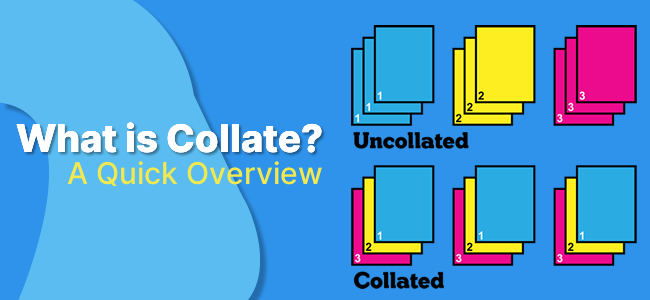In the realm of printing, certain phrasings can once in a while be confounding, particularly for those new to the business. One such term is “collate.”
In the event that you’ve gone over this term and wound up considering what it implies with regard to printing, you’ve come to the perfect locations. In this extensive article, we will dig into the idea of examining, its significance in printing, and how it can upgrade your general printing experience.
What is Collate?
Collate means to “gather and collect printed pieces of paper inside a foreordained request or succession. Ordinarily, every one of the pages in the report will print once”. When complete, the machine will rehash the interaction by printing a subsequent set. This goes on until the mentioned number of record sets is finished. Uncollated pages are heaps of printed pages in which a stack contains pages of similar data. Notwithstanding, each heap of printed paper is not quite the same as different stacks. That is a great deal of text to peruse to make sense of something that you’ve presumably found in your regular day-to-day existence. Here is a graph that shows the contrast between a ventures that is gathered versus uncollated.
Automatic Vs Manual Collating
Collating a report can be done easily by pressing the “collate” button on a multifunction printer. However, to change stocks within the report, you may need to start with separate print runs for each page to be printed on the main stock and another for each page to be printed on a subsequent stock. These archives can be collected as isolated print runs, but you must manually order specialty pages into your larger standard page record. A reference booklet with printed dividers can be used to stamp the start of each part. You may also need to consult your Print Administration partner or review the machine’s manual. Multifunction printer models can connect programming to the front end, allowing users to set paper usage for an ordered printing project. Understanding how to group a printed project can lead to more innovative and regulatory skills.
Difference between Collate & Uncollated
The terms “collated” and “uncollated” refer to different methods of organizing different copies of a record or a group of records. Grouped records are organized in a specific order, while uncollated records are not organized in a specific order. For example, if you print three uncollated copies of a multi-page report, you will end up with three separate piles of pages, each containing all the pages of the report but not all together. The choice between examined and uncollated printing depends on your needs and how you plan to use the reports. Examined printing is often preferred for maintaining the correct control of pages, such as for manuals, booklets, or gifts. Uncollated printing can be beneficial for creating individual arrangements of pages that can be easily circulated or arranged later, or for reports that require multiple segments to be collected independently.
Collated material process
Collecting printed materials is a straightforward process, whether done physically or using printer or print services. To effectively organize your files, follow these steps:
- Determine the ideal request: Consider factors like page numbers, section divisions, or specific record requirements.
- Choose the appropriate resemblance option: Check the printer manual for available resemblance options and choose the one that aligns with your desired request.
- Double-check the resemblance settings before starting the print work to avoid errors in the final output.
- Print and confirm: Start the printing system and check the pages are arranged correctly as per your desired request. If any issues arise, consult the printer’s manual or seek help from a print specialist co-op.
Advantages of Collating
Collating is printing various duplicates of different page reports. Some time ago, prior to printing programming, you needed to examine it physically. Be that as it may, we as of now do not live in obscurity ages, so today we order predominantly for 3 reasons. Efficient: No manual page arranging. This further develops business work processes and saves significant time, particularly while printing huge different page reports. Comfort: There’s no additional work. Reports are prepared to utilize following printing since they’re now coordinated in the right request. Exactness: Diminished the gamble of losing or stirring up pages. You don’t have to twofold check pages are properly aligned.
Uses of Collating
Collating can offer some benefits in the work environment, as it allows for more efficient organization and reduces the need for consecutive printing of pages, as seen in common models.
- Print Reports: keeps the right control of pages for simple reference and cognizance.
- Introductions: guarantees each arrangement of slides is organized in the expected request for consistent conveyance and successful correspondence.
- Manuals, Guidelines, and Guides: conveys a legitimate grouping of pages significant for understanding and following strategies.
- Solicitations, Proclamations, and Charging Records: guarantees client data is imprinted in a sound and coordinated way.
Conclusion:
Collating is a fundamental part of the printing system that guarantees your reports are methodical and efficient. Understanding the importance of “collate” and its importance in printing can significantly help your printing projects.
Collating is an imperative capability in printing that guarantees the right request of pages in different duplicates of a report. Whether you’re printing a multi-page report, a booklet, or a bunch of flyers, the examine capability can save you time and guarantee the exactness of your print work. So whenever you’re going to print numerous duplicates of a report, make sure to check whether your printer’s order capability is turned on. It could save you a great deal of time and exertion over the long haul.
Understanding the job and significance of collating in printing can assist you with capitalizing on your printing projects, whether you’re printing at home or utilizing an expert printing administration. So the following time you have an enormous print work, recall the force of collation. A little component can have a major effect.


Can you be more specific about the content of your article? After reading it, I still have some doubts. Hope you can help me.
Thanks for sharing. I read many of your blog posts, cool, your blog is very good.
Thank you for your sharing. I am worried that I lack creative ideas. It is your article that makes me full of hope. Thank you. But, I have a question, can you help me?
Your point of view caught my eye and was very interesting. Thanks. I have a question for you.
Thanks for sharing. I read many of your blog posts, cool, your blog is very good.
Your point of view caught my eye and was very interesting. Thanks. I have a question for you.
Thank you for your sharing. I am worried that I lack creative ideas. It is your article that makes me full of hope. Thank you. But, I have a question, can you help me?
Thanks for sharing. I read many of your blog posts, cool, your blog is very good.
Thanks for sharing. I read many of your blog posts, cool, your blog is very good.
Your point of view caught my eye and was very interesting. Thanks. I have a question for you.
Your point of view caught my eye and was very interesting. Thanks. I have a question for you.
Thank you for your sharing. I am worried that I lack creative ideas. It is your article that makes me full of hope. Thank you. But, I have a question, can you help me?
порно
I don’t think the title of your article matches the content lol. Just kidding, mainly because I had some doubts after reading the article.
medicine in mexico pharmacies
https://cmqpharma.com/# mexico drug stores pharmacies
buying from online mexican pharmacy
mexican online pharmacies prescription drugs: mexican pharmacy – mexico pharmacy
Can you be more specific about the content of your article? After reading it, I still have some doubts. Hope you can help me.
Your point of view caught my eye and was very interesting. Thanks. I have a question for you.
Very interesting information!Perfect just what I was looking for!Blog money
Can you be more specific about the content of your article? After reading it, I still have some doubts. Hope you can help me.
Thanks for sharing. I read many of your blog posts, cool, your blog is very good.
Thank you for your sharing. I am worried that I lack creative ideas. It is your article that makes me full of hope. Thank you. But, I have a question, can you help me?
Your point of view caught my eye and was very interesting. Thanks. I have a question for you.
mail order pharmacy india [url=https://indiapharmast.com/#]reputable indian pharmacies[/url] п»їlegitimate online pharmacies india
canada drugs online: canadian pharmacy 24 com – canadian pharmacy review
online canadian pharmacy: legit canadian online pharmacy – canadapharmacyonline legit
https://canadapharmast.com/# canada drugs reviews
indian pharmacy: online shopping pharmacy india – india pharmacy
best online pharmacy india [url=https://indiapharmast.com/#]indian pharmacies safe[/url] indianpharmacy com
medicine in mexico pharmacies: mexico pharmacies prescription drugs – mexican drugstore online
canadian drug pharmacy: canadianpharmacymeds – best canadian pharmacy
https://canadapharmast.online/# canadian drugs pharmacy
п»їlegitimate online pharmacies india: world pharmacy india – п»їlegitimate online pharmacies india
mexican mail order pharmacies [url=https://foruspharma.com/#]mexico drug stores pharmacies[/url] mexico pharmacies prescription drugs
online canadian pharmacy: canadian online pharmacy – pharmacy canadian superstore
canadian pharmacy prices: canadian pharmacy online store – buying drugs from canada
indianpharmacy com: best online pharmacy india – online pharmacy india
https://indiapharmast.com/# buy medicines online in india
reputable mexican pharmacies online: mexican border pharmacies shipping to usa – mexican pharmaceuticals online
http://paxloviddelivery.pro/# paxlovid pharmacy
generic amoxicillin online [url=https://amoxildelivery.pro/#]buy amoxicillin 500mg capsules uk[/url] where can i get amoxicillin 500 mg
https://clomiddelivery.pro/# can i purchase generic clomid tablets
amoxicillin capsule 500mg price: can i purchase amoxicillin online – amoxicillin 500mg without prescription
https://amoxildelivery.pro/# amoxicillin 500mg cost
how to get cheap clomid pills [url=https://clomiddelivery.pro/#]how to get cheap clomid tablets[/url] where can i buy generic clomid pill
https://clomiddelivery.pro/# how to get generic clomid price
https://paxloviddelivery.pro/# Paxlovid over the counter
best pharmacy online no prescription doxycycline [url=http://doxycyclinedelivery.pro/#]buy doxycycline pills online[/url] doxycycline online pharmacy canada
paxlovid covid: п»їpaxlovid – buy paxlovid online
http://amoxildelivery.pro/# buy amoxicillin online without prescription
https://paxloviddelivery.pro/# paxlovid for sale
https://amoxildelivery.pro/# amoxicillin 500mg capsules antibiotic
doxycycline online india [url=https://doxycyclinedelivery.pro/#]doxycycline acne[/url] doxycycline cost india
purchase amoxicillin online without prescription: amoxicillin 500 mg without a prescription – amoxicillin online purchase
https://amoxildelivery.pro/# amoxicillin over counter
http://doxycyclinedelivery.pro/# doxycycline 40 mg capsules
buy cheap clomid [url=https://clomiddelivery.pro/#]order generic clomid without rx[/url] cheap clomid without dr prescription
http://paxloviddelivery.pro/# paxlovid price
cipro pharmacy: cipro for sale – п»їcipro generic
https://ciprodelivery.pro/# cipro online no prescription in the usa
oral doxycycline [url=https://doxycyclinedelivery.pro/#]doxycycline canada brand name[/url] buy doxycycline 100mg capsules
http://paxloviddelivery.pro/# paxlovid buy
https://ciprodelivery.pro/# buy cipro online
ciprofloxacin [url=http://ciprodelivery.pro/#]buy cipro[/url] cipro for sale
buy doxycycline online no prescription: 40mg doxycycline online – cost of doxycycline in canada
http://clomiddelivery.pro/# order clomid prices
https://clomiddelivery.pro/# buying clomid
ciprofloxacin 500mg buy online [url=http://ciprodelivery.pro/#]buy cipro[/url] ciprofloxacin 500 mg tablet price
buying generic clomid no prescription: where buy generic clomid tablets – get generic clomid tablets
paxlovid for sale: Paxlovid over the counter – paxlovid for sale